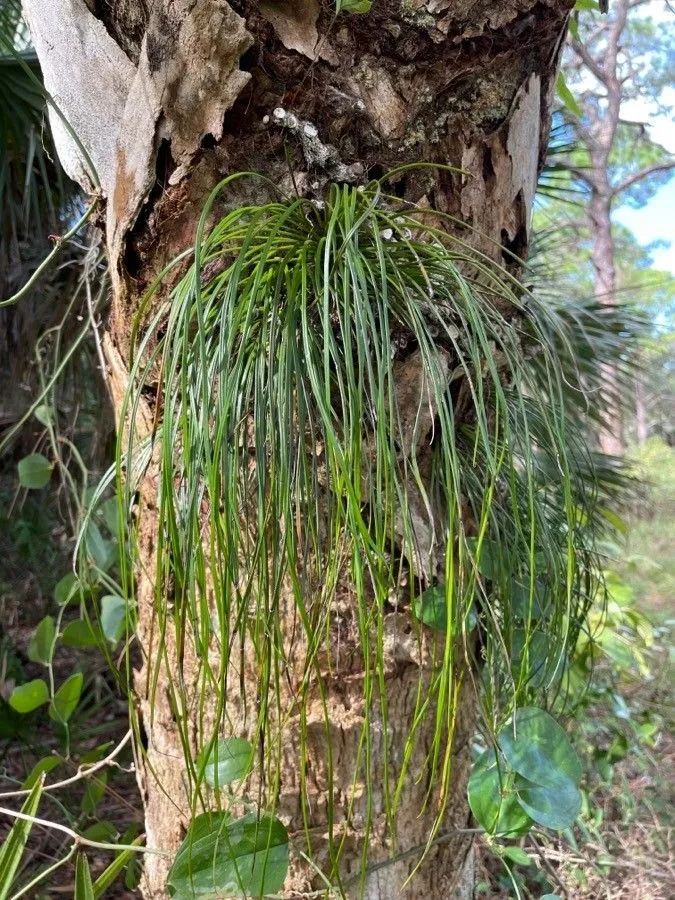
Author: (L.) Sm.
Bibliography: Mém. Acad. Roy. Sci. (Turin) 5. 421 t. 9 f. 5 HB. 39 (1793)
Year: 1793
Status: accepted
Rank: species
Genus: Vittaria
Vegetable: False
Observations: Trop. & Subtrop. America
The Shoestring Fern, scientifically referred to as Vittaria lineata, is an intriguing member of the Pteridaceae family, predominantly found across tropical and subtropical regions of the Americas. Known for its distinctive appearance, the Shoestring Fern thrives in humid environments and is often seen gracing the trunks of trees and shaded rocky crevices in forests, contributing to the lush greenery typical of these areas.
First described in a scientific context in the late 18th century (1793) by botanists as recorded in the Mém. Acad. Roy. Sci. (Turin), the Shoestring Fern has since captured the interest of botanists and plant enthusiasts alike. Its elongated, narrow fronds which resemble shoe laces, give this fern its common name and contribute to its unique, delicate charm within the forest understory.
Adapted to its specific habitat, Vittaria lineata typically forms dense, green mats that provide not only a visual appeal but also play an essential role in the ecosystem by offering habitat and moisture retention for various forest floor organisms. Its ability to thrive in low light and its preference for moist conditions make it a resilient plant, well-suited to the fluctuating environments of tropical and subtropical regions.
Interestingly, the Shoestring Fern has evolved several adaptive strategies to ensure its survival and proliferation in its preferred environment. Its creeping rhizomes allow it to spread efficiently over surfaces, often forming extensive cover in suitable locales. It’s also an epiphytic fern, meaning it often grows non-parasitically upon other plants, particularly tree trunks, without detracting nutrients from its host.
In horticulture and for fern enthusiasts, the Shoestring Fern can be an attractive addition to tropical-themed gardens and terrariums, provided it is given adequate humidity and shade mimicking its natural conditions. Its intricate and slender fronds make it a standout specimen, offering a touch of the tropics to indoor plant collections and garden landscapes alike.
Through its graceful yet hardy presence, the Shoestring Fern, Vittaria lineata, exemplifies the beauty and resilience of fern species adapted to some of the most dynamic ecological niches on our planet.
Swe: bandbräken
Eng: shoestring fern
En: Shoestring fern
Sv: Bandbräken
Taken Jan 1, 1900 by EOL − Petra Ballings (cc-by-nc)
Taken Apr 17, 2019 by OTS – R. Aguilar (cc-by-nc-sa)
Taken Apr 17, 2019 by OTS – R. Aguilar (cc-by-nc-sa)
Taken Apr 17, 2019 by OTS – R. Aguilar (cc-by-nc-sa)
Taken Nov 14, 2021 by Natalia Medina (cc-by-sa)
Taken Mar 14, 2022 by ( ˘-˘)っ♨ Эвелина (cc-by-sa)
Taken Jan 2, 2022 by Teresa Teresa (cc-by-sa)
Taken Apr 17, 2019 by OTS – R. Aguilar (cc-by-nc-sa)
Taken Aug 3, 2022 by Gabriel Gabriel Caldas (cc-by-sa)
© copyright of the Board of Trustees of the Royal Botanic Gardens, Kew.
© copyright of the Board of Trustees of the Royal Botanic Gardens, Kew.
© copyright of the Board of Trustees of the Royal Botanic Gardens, Kew.
Taken Mar 14, 2022 by ( ˘-˘)っ♨ Эвелина (cc-by-sa)
Taken Apr 17, 2019 by OTS – R. Aguilar (cc-by-nc-sa)
Taken Apr 17, 2019 by OTS – R. Aguilar (cc-by-nc-sa)
Growth habit>: Forb/herb
Family: Myrtaceae Author: (F.Muell.) K.D.Hill & L.A.S.Johnson Bibliography: Telopea 6: 402 (1995) Year: 1995 Status:…
Family: Rubiaceae Author: Pierre ex A.Froehner Bibliography: Notizbl. Bot. Gart. Berlin-Dahlem 1: 237 (1897) Year:…
Family: Sapindaceae Author: Koidz. Bibliography: J. Coll. Sci. Imp. Univ. Tokyo 32(1): 38 (1911) Year:…
Family: Asteraceae Author: A.Gray Bibliography: Pacif. Railr. Rep.: 107 (1857) Year: 1857 Status: accepted Rank:…
Family: Fabaceae Author: Medik. Bibliography: Vorles. Churpfälz. Phys.-Ökon. Ges. 2: 398 (1787) Year: 1787 Status:…
Family: Aspleniaceae Author: (Cav.) Alston Bibliography: Bull. Misc. Inform. Kew 1932: 309 (1932) Year: 1932…